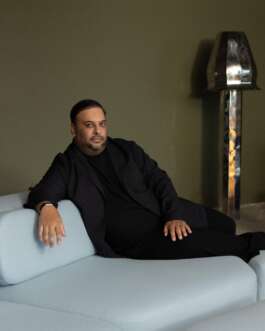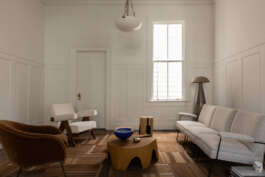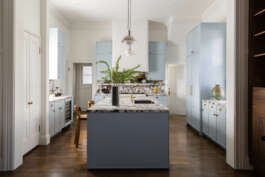



© Katie McCurdy
COLLECTIBLE Three questions to
Michael Hilal
June 2025
Today we have the pleasure of speaking with Michael Hilal, curator of VIGNETTE at COLLECTIBLE New York 2025. He creates spaces inspired by the easy living and sun-kissed imperfection of his home state of California. His practice lies at the intersection of interiors, objects, art, and fashion, and he collaborates with artists and artisans from diverse communities and backgrounds. Subverting the concept of formality, Michael’s spaces are bespoke and put-together, yet relaxed and approachable.
COLLECTIBLE: VIGNETTE offers a glimpse into an interior designer’s world—a small, concentrated space where they can invite others in, experiment with ideas, or reframe existing pieces. How do you see this format influencing the way we engage with collectible design in a fair context?
Michael Hilal : VIGNETTE offers a welcome shift from the conventional fair format, by focusing on an intimate, curated space, it invites viewers into the designer’s process rather than just their product. It’s less about consumption and more about conversation—between object and space, history and reinvention. In many ways, it operates like a store window—but one that is a snapshot into a designer’s mind.
What sets VIGNETTE apart is the freedom it offers to juxtapose eras—to pair contemporary work with vintage pieces, allowing the past to speak alongside the present. That contrast deepens the narrative and adds emotional weight; it becomes less about trends and more about continuity, memory, and the evolving language of design.
For me, it’s a chance to explore narrative, to stage ideas that might be too nuanced or experimental for a typical client project. In a fair context, where speed and spectacle often dominate, VIGNETTE slows the gaze. It encourages a different kind of engagement—one rooted in observation, curiosity, and emotional connection. It turns design into a form of storytelling rather than inventory.
C: Interior designers are becoming increasingly present in the collectible design world. What does it mean to offer them a dedicated curatorial platform at a fair like COLLECTIBLE?
MH:Giving interior designers a curatorial platform at a fair like COLLECTIBLE feels like a quiet rebellion against the old “design vs. decoration” divide. We’ve long been cast as the finishers—fluff the pillows, light a candle—but in reality, we’re the ones stitching the whole thing together. We connect the architecture to the objects, and the objects to the person living among them. It’s not just styling—it’s constructing a point of view.
This platform lets us step out of the service role and into something more critical—and frankly, more interesting. It’s a chance to question what collectible design actually means: not just arranging for visual harmony, but for tension, memory, and meaning. It also opens the door to mixing eras—the vintage with the new, the imperfect with the pristine—because that’s how people actually live. Not everything needs to be freshly lacquered.
We’re not staging objects in a vacuum. We’re building a world where they can speak to one another—and to us. And bringing interior designers into that conversation isn’t just inclusive. It shifts the entire dynamic. Quietly, and on purpose.
C: Your work often navigates the boundary between domesticity and curated environments. As a designer, how do you approach the notion of 'collecting' within an interior—not just functionally, but as a narrative or emotional gesture?
MH: I don’t approach collecting as a checklist—it’s not “one from the '50s, one Italian, one ‘editorial’ (read: barely functional).” I treat it more like casting. Every object has to earn its place—not just aesthetically, but in the way it shifts the energy of the room. Sometimes that’s about emotional weight, sometimes it's pure attitude.
For me, collecting within an interior isn’t about filling space—it’s about creating friction, resonance, memory. A vintage piece doesn’t just sit there to look noble and old—it’s there to throw the new work into sharper focus, to complicate the story.
There’s always a tension between the curated and the lived-in. I like rooms that feel edited, but never sterile. A good interior should hold together like a paragraph—intentional, composed, but still with breath in it.
And honestly, I’m not interested in collecting as social currency. If you’re acquiring just to prove you’ve “arrived,” you’re probably missing the point. I want pieces with presence—not just provenance.

© Lauren Edith Andersen / Sen Creative

© Lauren Edith Andersen / Sen Creative

© Katie McCurdy
COLLECTIBLE Three questions to
Michael Hilal
June 2025
Today we have the pleasure of speaking with Michael Hilal, curator of VIGNETTE at COLLECTIBLE New York 2025. He creates spaces inspired by the easy living and sun-kissed imperfection of his home state of California. His practice lies at the intersection of interiors, objects, art, and fashion, and he collaborates with artists and artisans from diverse communities and backgrounds. Subverting the concept of formality, Michael’s spaces are bespoke and put-together, yet relaxed and approachable.
COLLECTIBLE: VIGNETTE offers a glimpse into an interior designer’s world—a small, concentrated space where they can invite others in, experiment with ideas, or reframe existing pieces. How do you see this format influencing the way we engage with collectible design in a fair context?
Michael Hilal : VIGNETTE offers a welcome shift from the conventional fair format, by focusing on an intimate, curated space, it invites viewers into the designer’s process rather than just their product. It’s less about consumption and more about conversation—between object and space, history and reinvention. In many ways, it operates like a store window—but one that is a snapshot into a designer’s mind.
What sets VIGNETTE apart is the freedom it offers to juxtapose eras—to pair contemporary work with vintage pieces, allowing the past to speak alongside the present. That contrast deepens the narrative and adds emotional weight; it becomes less about trends and more about continuity, memory, and the evolving language of design.
For me, it’s a chance to explore narrative, to stage ideas that might be too nuanced or experimental for a typical client project. In a fair context, where speed and spectacle often dominate, VIGNETTE slows the gaze. It encourages a different kind of engagement—one rooted in observation, curiosity, and emotional connection. It turns design into a form of storytelling rather than inventory.
C: Interior designers are becoming increasingly present in the collectible design world. What does it mean to offer them a dedicated curatorial platform at a fair like COLLECTIBLE?
MH:Giving interior designers a curatorial platform at a fair like COLLECTIBLE feels like a quiet rebellion against the old “design vs. decoration” divide. We’ve long been cast as the finishers—fluff the pillows, light a candle—but in reality, we’re the ones stitching the whole thing together. We connect the architecture to the objects, and the objects to the person living among them. It’s not just styling—it’s constructing a point of view.
This platform lets us step out of the service role and into something more critical—and frankly, more interesting. It’s a chance to question what collectible design actually means: not just arranging for visual harmony, but for tension, memory, and meaning. It also opens the door to mixing eras—the vintage with the new, the imperfect with the pristine—because that’s how people actually live. Not everything needs to be freshly lacquered.
We’re not staging objects in a vacuum. We’re building a world where they can speak to one another—and to us. And bringing interior designers into that conversation isn’t just inclusive. It shifts the entire dynamic. Quietly, and on purpose.
C: Your work often navigates the boundary between domesticity and curated environments. As a designer, how do you approach the notion of 'collecting' within an interior—not just functionally, but as a narrative or emotional gesture?
MH: I don’t approach collecting as a checklist—it’s not “one from the '50s, one Italian, one ‘editorial’ (read: barely functional).” I treat it more like casting. Every object has to earn its place—not just aesthetically, but in the way it shifts the energy of the room. Sometimes that’s about emotional weight, sometimes it's pure attitude.
For me, collecting within an interior isn’t about filling space—it’s about creating friction, resonance, memory. A vintage piece doesn’t just sit there to look noble and old—it’s there to throw the new work into sharper focus, to complicate the story.
There’s always a tension between the curated and the lived-in. I like rooms that feel edited, but never sterile. A good interior should hold together like a paragraph—intentional, composed, but still with breath in it.
And honestly, I’m not interested in collecting as social currency. If you’re acquiring just to prove you’ve “arrived,” you’re probably missing the point. I want pieces with presence—not just provenance.

© Lauren Edith Andersen / Sen Creative

© Lauren Edith Andersen / Sen Creative
Contact
info@collectible.design
VIP PORTAL
EXHIBITOR PORTAL
PRIVACY POLICY
© 2025 Collectible
Contact
info@collectible.design
VIP PORTAL
EXHIBITOR PORTAL
PRIVACY POLICY
© 2025 Collectible